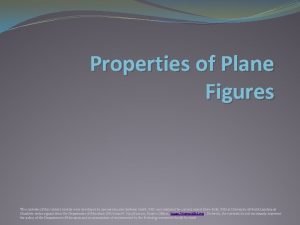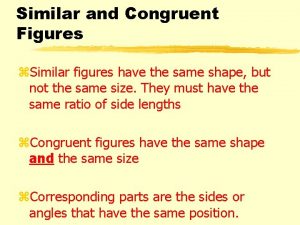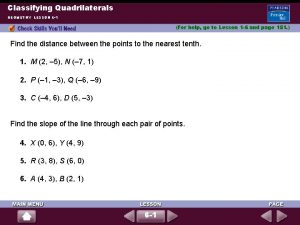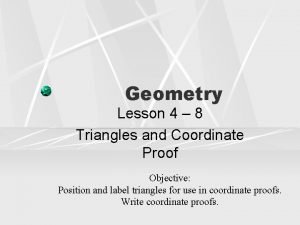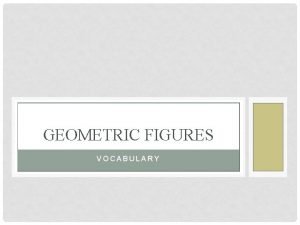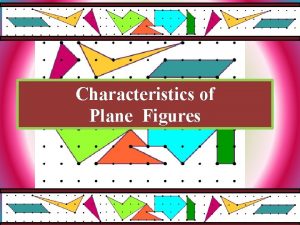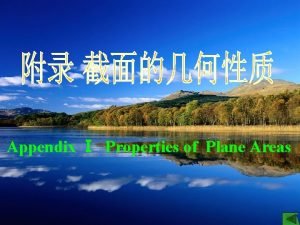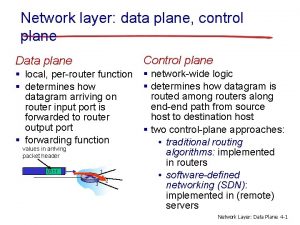Properties of Plane Figures The contents of this







- Slides: 7

Properties of Plane Figures The contents of this content module were developed by special educator Bethany Smith, Ph. D and validated by content expert Drew Polly, Ph. D at University of North Carolina at Charlotte under a grant from the Department of Education (PR/Award #: H 373 X 100002, Project Officer, Susan. Weigert@Ed. gov). However, the contents do not necessarily represent the policy of the Department of Education and no assumption of endorsement by the Federal government should be made

What is a plane figure? �Figures that are 2 D or can be drawn flat that have no thickness �These plane figures are called polygons Helpful Hint: If working with a �Polygons are: � Closed plane figures � Made up of line segments student hasn’t learned numbers yet. Review number identification on x and y axis � Two sides meet at each index � Sides do not cross each other The contents of this content module were developed by special educator Bethany Smith, Ph. D and validated by content expert Drew Polly, Ph. D at University of North Carolina at Charlotte under a grant from the Department of Education (PR/Award #: H 373 X 100002, Project Officer, Susan. Weigert@Ed. gov). However, the contents do not necessarily represent the policy of the Department of Education and no assumption of endorsement by the Federal government should be made

Types of Polygons �Polygons are named by the number of sides Common Polygons: 3 sides- Triangle 4 sides- Quadrilateral 5 sides- Pentagon 6 sides- Hexagon 8 sides- Octagon Helpful Hints: If working with a student who can not identify shapes, this is a perfect time to work on this skill while focusing on the properties of the polygon. For example, the square is a quadrilateral. It has 4 sides The contents of this content module were developed by special educator Bethany Smith, Ph. D and validated by content expert Drew Polly, Ph. D at University of North Carolina at Charlotte under a grant from the Department of Education (PR/Award #: H 373 X 100002, Project Officer, Susan. Weigert@Ed. gov). However, the contents do not necessarily represent the policy of the Department of Education and no assumption of endorsement by the Federal government should be made

Parts of a polygon Exterior angle- angle formed by two adjacent sides outside the polygon Side- one line segment that makes up the polygon Interior angle- angle formed by two adjacent sides inside the polygon Vertex- point where two sides meet The contents of this content module were developed by special educator Bethany Smith, Ph. D and validated by content expert Drew Polly, Ph. D at University of North Carolina at Charlotte under a grant from the Department of Education (PR/Award #: H 373 X 100002, Project Officer, Susan. Weigert@Ed. gov). However, the contents do not necessarily represent the policy of the Department of Education and no assumption of endorsement by the Federal government should be made

Regular or Irregular Regular Polygons Irregular Polygons �Sides are same length �Angles are the same �If not a regular polygon, then it is irregular �Examples: �Examples The contents of this content module were developed by special educator Bethany Smith, Ph. D and validated by content expert Drew Polly, Ph. D at University of North Carolina at Charlotte under a grant from the Department of Education (PR/Award #: H 373 X 100002, Project Officer, Susan. Weigert@Ed. gov). However, the contents do not necessarily represent the policy of the Department of Education and no assumption of endorsement by the Federal government should be made

Ideas for application �Identify common polygons found in the environment � Street signs �Ask students to sort regular and irregular polygons focusing on the concept of “same” pertaining to length of sides The contents of this content module were developed by special educator Bethany Smith, Ph. D and validated by content expert Drew Polly, Ph. D at University of North Carolina at Charlotte under a grant from the Department of Education (PR/Award #: H 373 X 100002, Project Officer, Susan. Weigert@Ed. gov). However, the contents do not necessarily represent the policy of the Department of Education and no assumption of endorsement by the Federal government should be made

Making connections �Identifying properties of plane figures addresses the following 4 th and 5 th grade Core Content Connectors � 4. GM. 1 h 2 Classify two-dimensional shapes based on attributes � 4. GM. 1 j 1 Recognize a point, line segments, and rays in two-dimensional figures � 4. GM. 1 j 2 Recognize perpendicular and parallel lines in twodimensional figures � 5. GM. 1 j 1 Recognize parallel and perpendicular lines within the context of two-dimensional figures � 5. GM. 1 a 1 Recognize properties of simple plane figures � 5. GM. 1 b 1 Distinguish plane figures by their properties The contents of this content module were developed by special educator Bethany Smith, Ph. D and validated by content expert Drew Polly, Ph. D at University of North Carolina at Charlotte under a grant from the Department of Education (PR/Award #: H 373 X 100002, Project Officer, Susan. Weigert@Ed. gov). However, the contents do not necessarily represent the policy of the Department of Education and no assumption of endorsement by the Federal government should be made
 Whats a plane figure
Whats a plane figure Solid and plane figures
Solid and plane figures Software-defined networking: a comprehensive survey
Software-defined networking: a comprehensive survey Properties of plane figures
Properties of plane figures Two shapes that are congruent are also similar
Two shapes that are congruent are also similar Practice 6-1 classifying quadrilaterals
Practice 6-1 classifying quadrilaterals How to find missing coordinates of an isosceles triangle
How to find missing coordinates of an isosceles triangle Closed plane figure formed by three or more segments
Closed plane figure formed by three or more segments



